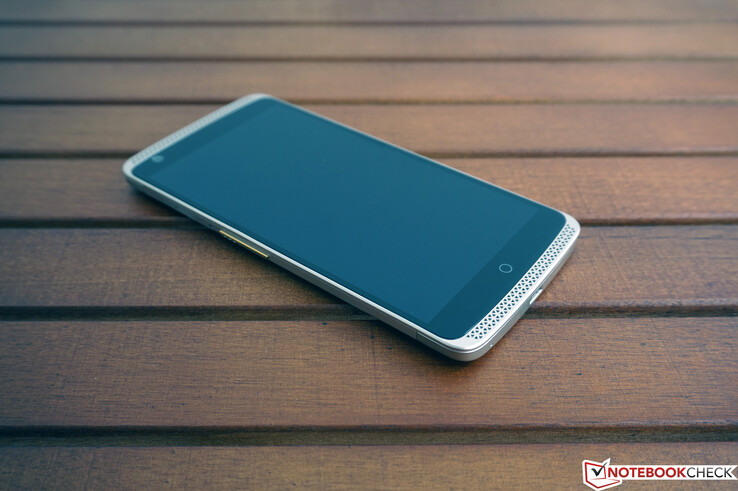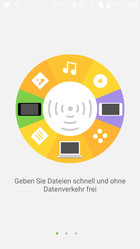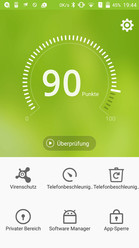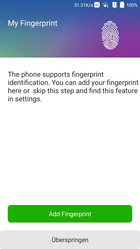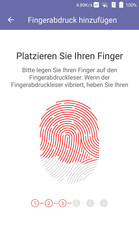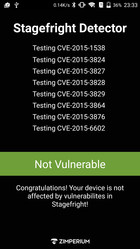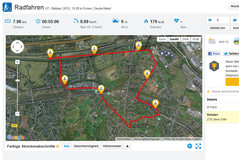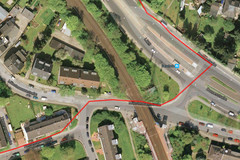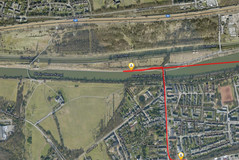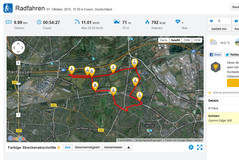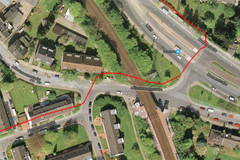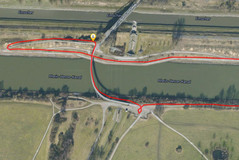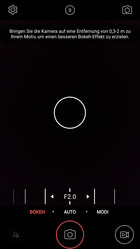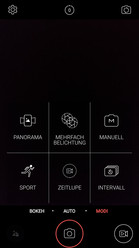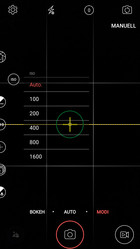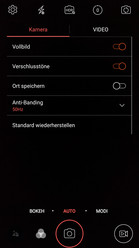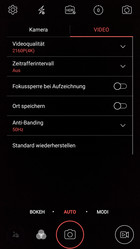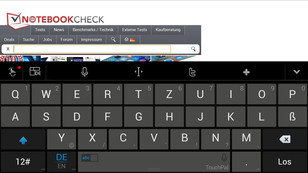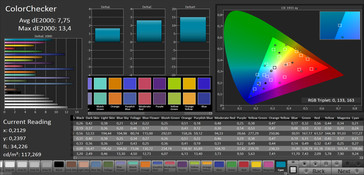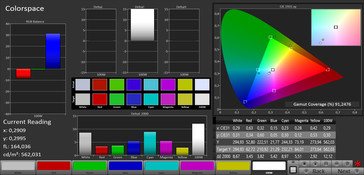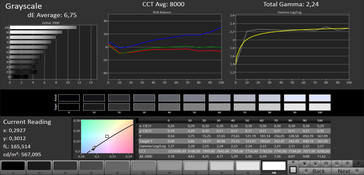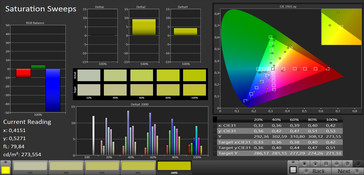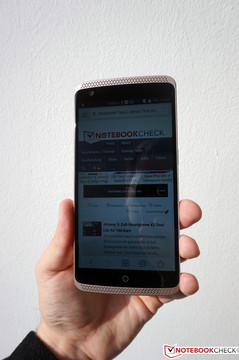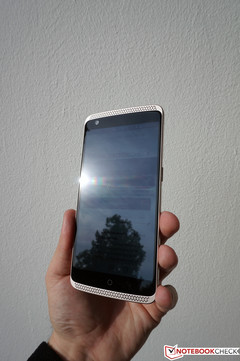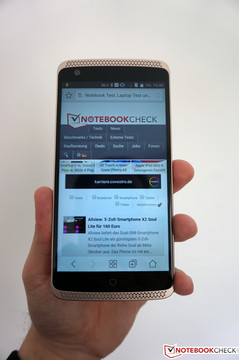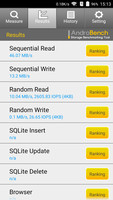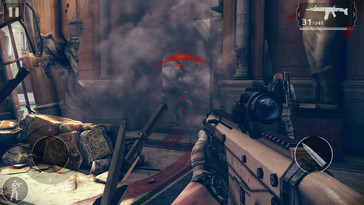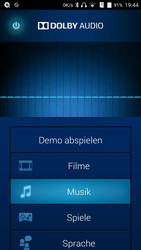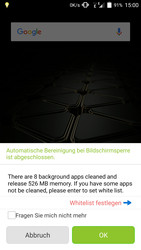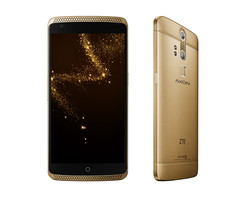ZTE Axon Elite Smartphone Review

For the original German review, see here.
The Chinese manufacturer ZTE now offers a flagship smartphone with the Axon Elite, which has many features including two biometric access options (fingerprint + voice recognition), two cameras at the back and the ability to use two SIM cards (Nano + Micro). The specifications are very solid, because Qualcomm’s SoC Snapdragon 810 with the Adreno 430 GPU is still one of the fastest chips on the market. You also get 3 GB of RAM and 32 GB of internal storage. The display measures 5.5 inches and has a resolution of 1920x1080 pixels. Our review unit is currently available for 449 Euros (~$495).
Many of the rivals use a similar technical basis, such as the OnePlus 2, the Huawei P8 and the Honor 6 Plus. Other alternatives are also flagship devices like the Xperia Z3 Plus, the LG G4 or the HTC One M9, which have been available for quite a while, so the prices are similar to the ZTE Axon Elite.
Note: This configuration of the ZTE Axon is currently not available in the United States. Instead, ZTE USA offers two other devices, the Axon and the Axon Pro with slightly different specifications. The results of our review unit are therefore not directly comparable.
Case
You instantly notice the bulky chassis when you pick up the ZTE Axon Elite for the first time. Both the length and the width exceed the comparison devices, and at 9.8 millimeters (~0.4 in/also see size comparison) the device is one of the thickest. However, unlike many of the rivals, the camera module at the back sits flush with the rest of the chassis. Because of the slightly rounded back, the 169 grams (~6 oz) smartphone does not feel inconvenient in the hand. Our review unit comes in "Ion Gold", but there is also a more subtle version in "Chromium Silver".
The overall design is – independent of the color – a bit too playful for our taste. Above and below the display is a pattern of triangles, which is also continued on the volume rocker and between the two camera modules at the back. The top and bottom of the rear look like leather, but it does not leave a sophisticated impression when you touch it and feels cheap compared to the rest of the aluminum chassis.
ZTE advertises a unibody construction, but you can clearly see the individual parts of the chassis. Nevertheless, the stability is very good since you cannot dent or twist the smartphone and there is no creaking sound. The battery is integrated and not accessible, and on the left side, there is only the combined slot for SIM cards (Nano + Micro) and a MicroSD-card. According to the specifications, Corning Gorilla Glass protects the display, but we could actually see small scratches on the display after a short while even though we were very careful with it. ZTE calls it a new kind of Gorilla Glass, which is also supposed to have an antimicrobial surface. We would still recommend an additional screen protector to avoid scratches.
Connectivity
As befits a flagship smartphone, the Axon Elite is equipped with very powerful components. Qualcomm’s Snapdragon 810 is no longer new, but it is still one of the fastest chips. This is also the case for the GPU Adreno 430. The SoC is supported by 3 GB of RAM, and 32 GB of internal storage should be sufficient. If the free storage of 23 GB after the initial start is not enough, you can expand it by up to 128 GB via MicroSD-card. In this case, only one SIM-card can be used because the Micro slot is a combined slot. Apps can be transferred to the SD-card after the installation, if they support it.
Besides the usual 3.5-mm stereo jack, you get a Micro-USB port, but it supports only the slower USB 2.0 standard. With USB 3.0 and the new USB-C port (USB 2.0 or 3.0); there are much faster and more comfortable alternatives. USB-OTG is supported, and a USB stick was easily recognized. On the other hand, MHL or SlimPort are not supported and you can only use Google Cast for connecting to a TV. In addition, there is an NFC chip and Android Beam for data exchange between two Android smartphones. We would have expected more from a flagship device.
Software
The operating system of the ZTE Axon is Android 5.0.1 Lollipop, but the Chinese manufacturer uses its own and quite heavily customized user interface, MiFavor 3.2. It dispenses with an app drawer and just lists the apps on the home screen. However, it is possible to create folders. You can quickly change the whole design of the UI with a swipe gesture from the bottom, including background pictures, the design of the symbols, the color of the menus and the animation when you switch between the different home screens. It is not yet clear if and when there will be an update to Android 6.
Fortunately, apart from some manufacturer's tools (Recovery, ActiveShare and Mi-Assistant) there are just two additional apps, which are actually quite useful: AccuWeather and WPS Office. The Mi-Assistant is particularly useful since it can quickly clean up the system and the memory. It is also possible to create a private environment, lock single apps or check the smartphone for viruses.
Overall, the system ran very smoothly during our review, we just encountered some issues when we installed the PCMark app, more specifically the downloading of the test within the app: The smartphone repeatedly deactivated itself and switched between the lock screen and the app. The smartphone did not react to inputs and only a restart of the smartphone helped. The problem also happened the next time, so we just left the smartphone alone this time and everything worked as intended after the installation. We did not have any problems with other apps, so this is probably an isolated incident.
The smartphone can be unlocked with the fingerprint scanner at the back, voice recognition or an iris scan. The fingerprint scanner at the back leaves the best impression, since it works very reliably and quickly. An unsuccessful attempt is indicated with a quick vibration. The voice recognition on the other hand did not work well. You have to speak at least two different words for the smartphone to recognize your voice. However, the unlocking only worked a couple of times during our review. The iris scan worked much better, but the procedure is pretty complicated, so it is not a real alternative for the fingerprint scanner. You have to swipe on the lock screen to access the unlocking pattern. Then you have to pull down this screen to start the iris scan. You will be dropped back to the lock screen if the scan did not work and then you have to repeat all the steps.
Communication & GPS
In addition to the HSDPA+ (downstream up to 42.2 Mbps, upstream up to 5.76 Mbps), the Axon Elite also supports LTE Cat. 6 with download speeds of up to 300 Mbps (uploads up to 50 Mbps). The reception in the metropolitan T-Mobile network was inconspicuous. Our review unit also supports the Wi-Fi standards 802.11 a/b/g/n/ac in 2.4 as well as 5 GHz networks. Even though the Snapdragon 810 would support Bluetooth 4.1, our review unit uses only Bluetooth 4.0. The smartphone could not establish a connection with our Fritz!Box 7490 when the network was WPA2 encrypted. We repeatedly got authentication errors both in 2.4 as well as 5 GHz networks, and neither a restart nor a reset of the Fritz!Box helped; the Axon Elite could only establish a connection with an unsecured network. We can rule out a problem with the router, since all other devices (including iOS, Windows, Android TV) had no problems with the Fritz!Box. There were, however, no issues with the Asus RT-AC56U and a Devolo dLAN 1200+ Wi-Fi ac (both WPA2), and the signal quality was decent.
The position of the Axon Elite can be located via GPS and the Russian GLONASS. It is not possible to get a location indoors, even close to a window, but it takes only a few seconds outdoors and the app GPS Test showed accurately down to 8 meters (~26 ft). We also checked the accuracy of the module on a bicycle ride and compared the results with the professional navigation device Garmin Edge 500. You can immediately see that the location dropped out in the middle of the ride and that the whole turning point is missing in the overview picture. This results in a difference of around two kilometers (~1.2 mi), which is 20% of the whole track length. The review unit is therefore not the most reliable solution for navigation purposes.
Telephone & Voice Quality
The phone app does not offer any surprises and is dominated by the large number pad. You can also access the contacts, groups and messages. It is possible to use different settings for the two SIM-cards, including the standard card for calls and select the mobile networks the cards can access.
We did not notice any issues during calls on our side, but the other person always noticed a quiet and steady background noise. We were also able to hear it during voice recordings and video recordings (see further below), so there seems to be an issue with the two microphones. The understandability was okay when we used the hands-free feature, but the voice quickly distorted via speaker.
Cameras & Multimedia
At the front of the Axon Elite is an 8 MP camera to comply with the current selfie trend. With a maximum of 3264 x 1836 pixels, the picture quality is average: Colors look rich, but the details are not really sharp even under good lighting conditions. You will also quickly notice picture noise in low-light situations since there is no flash.
There are two camera lenses on the back, because the 13 MP camera is accompanied by a 2 MP camera. The latter is supposed to capture additional information, which can be used for post-processing or effects. There is also a special Bokeh mode, where the background is blurry and the focus is concentrated on the actual motif.
The resolution is limited to ~9MP (4096x2304 pixels) in the automatic mode, the maximum resolution of 13 MP (4096x3072) is only available in the manual mode. It also offers more settings, including the ISO value, the shutter speed or the exposure. The manual mode however, needs more time to take a picture compared to the automatic mode. Unfortunately, there is no possibility of storing pictures and videos on the SD-card.
You can quickly notice the low brightness of the sample pictures when you compare the results with other devices and our reference camera. The pictures of the Axon Elite can impress with a good sharpness, but some elements are not clearly differentiated. This is particularly visible in the vegetation in scenes 1 and 2. Another issue is that the colors look rather pale. Once again, the brightness is lower in low-light situations (scene 3), but you can still see all the details and there is not much picture noise in comparison.
The rear camera can record videos in the 4K resolution (2160p) at 30 frames per second, and there are no restrictions due to temperature issues. The area next to the camera gets slightly warm, but that is it. You can also take pictures during the recording, although these are just screenshots from the video with a resolution of 3840x2160 pixels.
You can find a very handy feature in the settings, because you can activate a focus lock. This avoids unpleasant push effects that can happen when the camera focusses constantly. This will improve the quality particularly during movements. The picture quality itself leaves a good impression when the lighting is sufficient. Colors are vivid and fast movements are not a big problem for the camera. However, you can notice picture noise in low-light situations.
In addition to the previously mentioned focus lock, you can choose the resolution, the refresh rate (50/60 Hz) and set an interval for the time-lapse feature. Slow motions are hidden in the different camera modes, but the recordings are limited to 720p at 120 frames per second.
You can take 1080p videos with the front camera, and once again, the quality is okay under good lighting conditions. The biggest issue during all video recordings was a constant background noise, which was always audible.
Accessories
The box of the ZTE Axon Elite contains only the usual additions: Power adaptor (5 V, 1.5 A), headphones, data cable, SIM tool as well as a quick-start guide and a warranty card. Specials accessories are not offered by ZTE.
Warranty
The warranty period of the ZTE Axon is 24 months, but the accessories and the battery are only covered for 6 months.
Input Devices & Handling
ZTE does not use the standard Android keyboard by default, but TouchPal X. It offers comprehensive settings and supports common features like swipe inputs or word predictions. It is also possible to access Twitter directly. Because of the large number of features, the keyboard does appear slightly crowded and takes some time getting used to. It is obviously also possible to use the standard Android keyboard or use another model from the Play Store
The capacitive touchscreen recognizes up to 10 inputs simultaneously and provides good gliding capabilities. Our inputs were always executed quickly and reliably, even in the peripheral areas. Both the power button and the volume rocker are integrated into the chassis and have a well-defined pressure point.
Display
ZTE has equipped the Axon Elite with a 5.5-inch LC-IPS display. The native resolution is 1920x1080 pixels, which results in a very good pixel density of 401 PPI. Individual pixels are therefore not visible to the human eye. With the exception of the LG G4 (2560x1440), all comparison devices use FHD panels as well, but some devices have an advantage in terms of the pixel density due to smaller screen sizes.
The average luminance of the display is very high at almost 544 cd/m² and is only surpassed by the Sony Xperia Z3 Plus (around 600 cd/m²) in this comparison. The brightness distribution is also very good at 91%. One disadvantage of the panel is the high black value of 0.55 cd/m². The contrast is still higher than 1000:1 thanks to the high luminance, but this is only enough for the last place within the comparison. The picture is still subjectively rich, only black contents have a slight gray hue and could be darker. You will find two options in the settings to adjust the saturation (natural, colorful, splendid) and the color temperature (slide control) according to your own preferences.
| |||||||||||||||||||||||||
Brightness Distribution: 91 %
Contrast: 1033:1 (Black: 0.55 cd/m²)
ΔE ColorChecker Calman: 7.75 | ∀{0.5-29.43 Ø4.78}
ΔE Greyscale Calman: 6.75 | ∀{0.09-98 Ø5}
Gamma: 2.24
CCT: 8000 K
| ZTE Axon Elite Adreno 430, 810 MSM8994, 32 GB eMMC Flash | OnePlus 2 Adreno 430, 810 MSM8994, 64 GB eMMC Flash | Huawei P8 Mali-T628 MP4, Kirin 930, 16 GB eMMC Flash | Honor 6 Plus Mali-T628 MP4, Kirin 925, 32 GB eMMC Flash | Sony Xperia Z3+ Adreno 430, 810 MSM8994, 32 GB eMMC Flash | LG G4 Adreno 418, 808 MSM8992, 32 GB eMMC Flash | HTC One M9 Adreno 430, 810 MSM8994, 32 GB eMMC Flash | |
|---|---|---|---|---|---|---|---|
| Screen | 20% | 19% | 13% | -5% | 8% | 4% | |
| Brightness middle (cd/m²) | 568 | 451 -21% | 453 -20% | 472 -17% | 605 7% | 566 0% | 474 -17% |
| Brightness (cd/m²) | 544 | 446 -18% | 439 -19% | 471 -13% | 601 10% | 536 -1% | 458 -16% |
| Brightness Distribution (%) | 91 | 90 -1% | 91 0% | 93 2% | 92 1% | 90 -1% | 85 -7% |
| Black Level * (cd/m²) | 0.55 | 0.3 45% | 0.28 49% | 0.28 49% | 0.53 4% | 0.47 15% | 0.4 27% |
| Contrast (:1) | 1033 | 1503 45% | 1618 57% | 1686 63% | 1142 11% | 1204 17% | 1185 15% |
| Colorchecker dE 2000 * | 7.75 | 3.84 50% | 4.7 39% | 6.33 18% | 9.24 -19% | 6.17 20% | 6.32 18% |
| Greyscale dE 2000 * | 6.75 | 3.97 41% | 5.03 25% | 7.39 -9% | 10.01 -48% | 6.26 7% | 6.36 6% |
| Gamma | 2.24 98% | 2.46 89% | 2.27 97% | 2.34 94% | 2.22 99% | 2.48 89% | 2.43 91% |
| CCT | 8000 81% | 7283 89% | 7439 87% | 8227 79% | 10343 63% | 8171 80% | 8218 79% |
| Color Space (Percent of AdobeRGB 1998) (%) | 58.07 | 72.04 | 65.65 | 65.48 | 58.81 | ||
| Color Space (Percent of sRGB) (%) | 90.14 | 97.1 | 98.63 |
* ... smaller is better
We used a spectrophotometer and the software CalMAN to analyze the display. The average DeltaE-deviations compared to the sRGB color space are comparatively high with 7.75 for the colors and 6.75 for the grayscale ex-works. The target value is 3 or less, because usually deviations below this value are not visible to the human eye. The ZTE Axon Elite is at the bottom of the ranking with these results.
Compared to some other smartphones, the ZTE Axon Elite does not have a special outdoor mode, but the brightness of more than 500 cd/m² is still easily sufficient to see the display content under direct sunlight when you can avoid direct reflections. The maximum luminance is achieved with both the manual as well as the automatic control via a light sensor.
Performance
The ZTE Axon Elite is only available in one configuration with a Qualcomm Snapdragon 810, Adreno 430 GPU, 3 GB of RAM and 32 GB of internal storage. The octa-core processor supports 64-bit and consists of two clusters with four cores each that work in a big.LITTLE configuration. The four faster Cortex-A57 cores reach up to 2 GHz, while the four Cortex-A53 cores run at up to 1.3 GHz to save power. The SoC can also use all eight cores simultaneously if necessary.
The Snapdragon is still one of the fastest SoCs on the market, but there are more powerful chips available. Therefore, we have also listed the Samsung Galaxy S6 Edge Plus as well as the Apple iPhone 6S Plus in the benchmarks as examples. They are not direct rivals for our review unit, but the results are still interesting.
The results can differ depending on the benchmark, but the review unit is often faster than its direct rivals or at least on par. The Adreno 430 can sometimes even beat the Mali-T760 MP8 from the Galaxy S6 Edge Plus in the graphics benchmarks. The performance of the review unit is therefore very good.
| Geekbench 3 | |
| 64 Bit Multi-Core Score (sort by value) | |
| ZTE Axon Elite | |
| OnePlus 2 | |
| Huawei P8 | |
| Sony Xperia Z3+ | |
| LG G4 | |
| HTC One M9 | |
| Apple iPhone 6S Plus | |
| Samsung Galaxy S6 Edge+ | |
| 64 Bit Single-Core Score (sort by value) | |
| ZTE Axon Elite | |
| OnePlus 2 | |
| Huawei P8 | |
| Sony Xperia Z3+ | |
| LG G4 | |
| HTC One M9 | |
| Apple iPhone 6S Plus | |
| Samsung Galaxy S6 Edge+ | |
| PCMark for Android - Work performance score (sort by value) | |
| ZTE Axon Elite | |
| OnePlus 2 | |
| Huawei P8 | |
| Honor 6 Plus | |
| Sony Xperia Z3+ | |
| LG G4 | |
| HTC One M9 | |
| Samsung Galaxy S6 Edge+ | |
| AnTuTu v5 - Total Score (sort by value) | |
| ZTE Axon Elite | |
| OnePlus 2 | |
| Huawei P8 | |
| Honor 6 Plus | |
| Sony Xperia Z3+ | |
| LG G4 | |
| HTC One M9 | |
| Apple iPhone 6S Plus | |
| Samsung Galaxy S6 Edge+ | |
| GFXBench (DX / GLBenchmark) 2.7 | |
| T-Rex Onscreen (sort by value) | |
| ZTE Axon Elite | |
| OnePlus 2 | |
| Huawei P8 | |
| Honor 6 Plus | |
| Sony Xperia Z3+ | |
| LG G4 | |
| HTC One M9 | |
| Apple iPhone 6S Plus | |
| 1920x1080 T-Rex Offscreen (sort by value) | |
| ZTE Axon Elite | |
| OnePlus 2 | |
| Huawei P8 | |
| Honor 6 Plus | |
| Sony Xperia Z3+ | |
| LG G4 | |
| HTC One M9 | |
| Apple iPhone 6S Plus | |
| GFXBench 3.0 | |
| 1920x1080 1080p Manhattan Offscreen (sort by value) | |
| ZTE Axon Elite | |
| OnePlus 2 | |
| Huawei P8 | |
| Honor 6 Plus | |
| Sony Xperia Z3+ | |
| LG G4 | |
| HTC One M9 | |
| Apple iPhone 6S Plus | |
| Samsung Galaxy S6 Edge+ | |
| on screen Manhattan Onscreen OGL (sort by value) | |
| ZTE Axon Elite | |
| OnePlus 2 | |
| Huawei P8 | |
| Honor 6 Plus | |
| Sony Xperia Z3+ | |
| LG G4 | |
| HTC One M9 | |
| Apple iPhone 6S Plus | |
| Samsung Galaxy S6 Edge+ | |
| GFXBench 3.1 | |
| 1920x1080 Manhattan ES 3.1 Offscreen (sort by value) | |
| ZTE Axon Elite | |
| OnePlus 2 | |
| Sony Xperia Z3+ | |
| LG G4 | |
| HTC One M9 | |
| Apple iPhone 6S Plus | |
| on screen Manhattan ES 3.1 Onscreen (sort by value) | |
| ZTE Axon Elite | |
| OnePlus 2 | |
| Sony Xperia Z3+ | |
| LG G4 | |
| HTC One M9 | |
| Apple iPhone 6S Plus | |
We performed the web-based benchmarks with the preloaded browser, which is based on Chrome 45. The ZTE Axon Elite performs very well and can beat the comparison devices in almost all tests. Even the new Samsung Galaxy S6 Edge Plus is sometimes surpassed, but the iPhone 6S Plus is very fast in the browser tests and out of range.
| Sunspider - 1.0 Total Score (sort by value) | |
| ZTE Axon Elite | |
| OnePlus 2 | |
| Huawei P8 | |
| Honor 6 Plus | |
| Sony Xperia Z3+ | |
| LG G4 | |
| HTC One M9 | |
| Apple iPhone 6S Plus | |
| Samsung Galaxy S6 Edge+ | |
| Octane V2 - Total Score (sort by value) | |
| ZTE Axon Elite | |
| OnePlus 2 | |
| Huawei P8 | |
| Honor 6 Plus | |
| Sony Xperia Z3+ | |
| LG G4 | |
| HTC One M9 | |
| Apple iPhone 6S Plus | |
| Samsung Galaxy S6 Edge+ | |
| Mozilla Kraken 1.1 - Total (sort by value) | |
| ZTE Axon Elite | |
| OnePlus 2 | |
| Huawei P8 | |
| Honor 6 Plus | |
| Sony Xperia Z3+ | |
| LG G4 | |
| HTC One M9 | |
| Apple iPhone 6S Plus | |
| Samsung Galaxy S6 Edge+ | |
| Google V8 Ver. 7 - Google V8 Ver. 7 Score (sort by value) | |
| ZTE Axon Elite | |
| OnePlus 2 | |
| Huawei P8 | |
| Honor 6 Plus | |
| Sony Xperia Z3+ | |
| LG G4 | |
| HTC One M9 | |
| Apple iPhone 6S Plus | |
| Samsung Galaxy S6 Edge+ | |
| WebXPRT 2015 - Overall (sort by value) | |
| ZTE Axon Elite | |
| OnePlus 2 | |
| Huawei P8 | |
| Honor 6 Plus | |
| Sony Xperia Z3+ | |
| LG G4 | |
| HTC One M9 | |
| Apple iPhone 6S Plus | |
| Samsung Galaxy S6 Edge+ | |
| JetStream 1.1 - Total Score (sort by value) | |
| ZTE Axon Elite | |
| OnePlus 2 | |
| Honor 6 Plus | |
| Sony Xperia Z3+ | |
| LG G4 | |
| HTC One M9 | |
| Apple iPhone 6S Plus | |
| Samsung Galaxy S6 Edge+ | |
* ... smaller is better
The internal storage has a capacity of 32 GB (eMMC) and performs well in the benchmarks. The sequential results of 200 MB/s (read) and 110 MB/s (write), respectively, are only enough for a place in the middle of the pack, but there should not be any restrictions. We also checked the transfer rates of the MicroSD-card reader in combination with a Toshiba Exceria SD-CX32UHSI. We can only measure 46 MB/s (seq. read) and 13 MB/s (seq. write), so the card cannot use its full performance (up to 85 and 50 MB/s) and the copying of larger files in particular can take longer than necessary.
| BaseMark OS II - Memory (sort by value) | |
| ZTE Axon Elite | |
| OnePlus 2 | |
| Huawei P8 | |
| Honor 6 Plus | |
| Sony Xperia Z3+ | |
| LG G4 | |
| HTC One M9 | |
| Apple iPhone 6S Plus | |
| Samsung Galaxy S6 Edge+ | |
Games
We have already mentioned that the graphics chip Adreno 430 from Qualcomm is one of the fastest GPUs. Current games are therefore not a big challenge for the smartphone, a situation that should not change in the near future. Even demanding games like “Modern Combat” and “Asphalt 8” can be played smoothly.
The position sensors and the touchscreen work perfectly and did not affect the gaming experience. You should make sure that the Micro-USB port is facing towards the right side when you play in landscape mode, otherwise you can easily cover the speaker with the hand.
Emissions
Temperature
The Snapdragon 810 is known as a hothead, but at least the chassis temperatures are okay. The average temperatures at the top and the bottom are 31.5 and 29.5 °C (~89 and 85 °F) while idling. The upper part of the case in particular, warms up under load, but a maximum of 38.7 °C (~102 °F) is not inconvenient and the temperature distribution is pretty even.
How is the situation inside the smartphone? We use the GFXBench Battery Test to check if the SoC can maintain its performance under sustained load. The T-Rex test is repeated thirty times, while the app logs the performance and the temperature. The SoC starts to throttle after around 15 runs. The temperatures are still not very high, which suggests a pretty defensive temperature management by the manufacturer. The performance can therefore drop during prolonged gaming sessions, but the performance of the chip is so high that there should not be any problems with current games.
(+) The maximum temperature on the upper side is 38.7 °C / 102 F, compared to the average of 35.2 °C / 95 F, ranging from 21.9 to 247 °C for the class Smartphone.
(+) The bottom heats up to a maximum of 36.5 °C / 98 F, compared to the average of 34 °C / 93 F
(+) In idle usage, the average temperature for the upper side is 31.5 °C / 89 F, compared to the device average of 32.9 °C / 91 F.
Speaker
The expectations for the speakers of the ZTE Axon are very high, because it looks as if there are two modules on the front. However, unfortunately, this is not the case; there is just one speaker below the display. Unlike the HTC One M9, for example, the speaker above the display is only used as an earpiece during calls.
At least, the single speaker is surprisingly loud. The quality will suffer noticeably as soon as you exceed 75% of the maximum volume, but it is still sufficient for some background music or the occasional YouTube video. You also get the preloaded Dolby Digital Plus software, which can be accessed directly from the music app. The functionality is similar to the software that we know from many notebooks. In addition to the various presets for movies, music and voice, you can create two custom profiles. However, there is no full equalizer, but only some slide controls, so the selection is limited. The result was not very impressive. The quality did not improve noticeably and the maximum volume was not increased. You should deactivate the software for music playback in particular.
Next, we checked the performance of the 3.5 mm stereo jack. Our Sennheiser Urbanite XL headphones were specifically designed for mobile devices, but the maximum volume was still just loud enough in some cases. This means that the smartphone is not suitable for high-impedance Hi-Fi headphones. Besides normal .mp3 files, we also checked lossless.flac format songs, which are supported by the default music app. The playback with the normal files was good and powerful enough, but we missed some dynamic range and precision during the playback of the lossless files. Overall, a decent performance, but the advertised Hi-Fi performance is not quite achieved.
The connection with our Bluetooth speaker Denon Envaya Mini worked well, and dropouts did not affect the playback.
Energy Management
Power Consumption
The ZTE Axon Elite does not leave a good impression in terms of consumption measurements. The results under load are lower than some rivals at only 5.2 watts on average and a maximum of 6.2 watts. However, the review unit consumes much more power while idling. Even the minimum idle consumption is 3.4 Watts – the other devices are even more frugal at the highest luminance, so there is room for improvements.
The standby consumption of 2.8 Watts was initially an unpleasant surprise, but it can be easily explained: The ZTE Axon Elite performs a cleanup of apps and the memory during standby (see screenshot). Obviously, it consumes more power during this operation, but the value dropped to 0.1 Watts after that. Our review unit did not consume any power when it was turned off.
| Off / Standby | |
| Idle | |
| Load |
|
Key:
min: | |
| ZTE Axon Elite Adreno 430, 810 MSM8994, 32 GB eMMC Flash | OnePlus 2 Adreno 430, 810 MSM8994, 64 GB eMMC Flash | Huawei P8 Mali-T628 MP4, Kirin 930, 16 GB eMMC Flash | Honor 6 Plus Mali-T628 MP4, Kirin 925, 32 GB eMMC Flash | Sony Xperia Z3+ Adreno 430, 810 MSM8994, 32 GB eMMC Flash | LG G4 Adreno 418, 808 MSM8992, 32 GB eMMC Flash | HTC One M9 Adreno 430, 810 MSM8994, 32 GB eMMC Flash | |
|---|---|---|---|---|---|---|---|
| Power Consumption | 37% | 32% | 13% | 29% | 22% | 19% | |
| Idle Minimum * (Watt) | 3.4 | 0.6 82% | 0.7 79% | 1.6 53% | 0.6 82% | 1.1 68% | 1.1 68% |
| Idle Average * (Watt) | 3.8 | 1.7 55% | 2 47% | 3 21% | 2.5 34% | 1.5 61% | 2 47% |
| Idle Maximum * (Watt) | 4 | 1.8 55% | 2.1 47% | 3.2 20% | 2.7 32% | 1.9 52% | 2.4 40% |
| Load Average * (Watt) | 5.2 | 5.7 -10% | 4.9 6% | 5.6 -8% | 5.5 -6% | 6.6 -27% | 7.2 -38% |
| Load Maximum * (Watt) | 6.2 | 6 3% | 7.4 -19% | 7.6 -23% | 6.1 2% | 8.8 -42% | 7.5 -21% |
* ... smaller is better
Battery Runtime
The high consumption also affects the battery runtimes: The extreme scenarios under load and the reading of the text document in particular fall short of the competition.
The gap is smaller in the Wi-Fi and video tests with an adjusted brightness of 150 cd/m², but the review unit is once again behind many rivals. It is interesting that the video runtime even surpasses the supposedly maximum runtime that we determined at the lower brightness. This short result was confirmed in a second attempt. It seems to be a problem with the Wi-Fi module, which can probably be fixed with a software update. We sometimes had issues to manage a full day in practice. ZTE implements two energy-saving modes to increase the runtime if necessary. It is possible to reduce the CPU performance with the option "Smart Power", and there is the "long standby" option, which represents the common energy-saving mode with a reduced brightness, limited background services and reduced performance.
The smartphone supports Quick-Charge 2.0 to charge the battery in a short period. However, the scope of delivery only includes a power adaptor with a nominal output of 7.5 watts (5 V, 1.5 A), which is why you cannot use the advantages of quick charge without a different PSU. The information about the power adaptor comes directly from the manufacturer, because our review sample was delivered without one. Wireless charging is not supported by the ZTE Axon Elite. The notification light underneath the display is a nice addition. It pulsates gently when the device is charging and a full battery is indicated by a constant glow. This means that you do not always have to turn on the display to check the battery status.
| ZTE Axon Elite Adreno 430, 810 MSM8994, 32 GB eMMC Flash | OnePlus 2 Adreno 430, 810 MSM8994, 64 GB eMMC Flash | Huawei P8 Mali-T628 MP4, Kirin 930, 16 GB eMMC Flash | Honor 6 Plus Mali-T628 MP4, Kirin 925, 32 GB eMMC Flash | Sony Xperia Z3+ Adreno 430, 810 MSM8994, 32 GB eMMC Flash | LG G4 Adreno 418, 808 MSM8992, 32 GB eMMC Flash | HTC One M9 Adreno 430, 810 MSM8994, 32 GB eMMC Flash | |
|---|---|---|---|---|---|---|---|
| Battery runtime | 43% | 22% | 74% | 65% | 33% | 11% | |
| Reader / Idle (h) | 9.3 | 23.2 149% | 13.8 48% | 27.4 195% | 28.2 203% | 27.6 197% | 13.4 44% |
| H.264 (h) | 10.7 | 9.7 -9% | 9.7 -9% | 11.8 10% | 8.8 -18% | 8.4 -21% | 7 -35% |
| WiFi v1.3 (h) | 6.1 | 5.9 -3% | 7.2 18% | 8.9 46% | 6.5 7% | 5.4 -11% | 5.8 -5% |
| Load (h) | 2.8 | 3.8 36% | 3.6 29% | 4 43% | 4.7 68% | 1.9 -32% | 3.9 39% |
| WiFi (h) | 9.6 |
Pros
Cons
Verdict
The ZTE Axon Elite is the first flagship device from the manufacturer in Europe. The impression in our review was pretty mixed. The important aspects of marketing are well covered, because the chassis is well built, the display is very bright and the performance of our review unit is very good.
There are still some issues, which are not apparent when you look at the specifications and can affect the user experience. This does, for example, include the comparatively high power consumption in combination with the Wi-Fi module, which can probably be fixed with a software update. Other problems are the background noise during video recordings, the dropouts of the GPS module as well as connection issues of the Wi-Fi module. A look at the competitors is therefore recommended if you are not a big fan of the unique design.
The Axon Elite from the Chinese manufacturer ZTE is a decent first flagship smartphone. The technical basis is sophisticated and there are no serious issues that would prevent a purchase. However, the devil is in the details, and you will have to live with a few drawbacks in many areas.
ZTE Axon Elite
- 10/27/2015 v4 (old)
Andreas Osthoff




